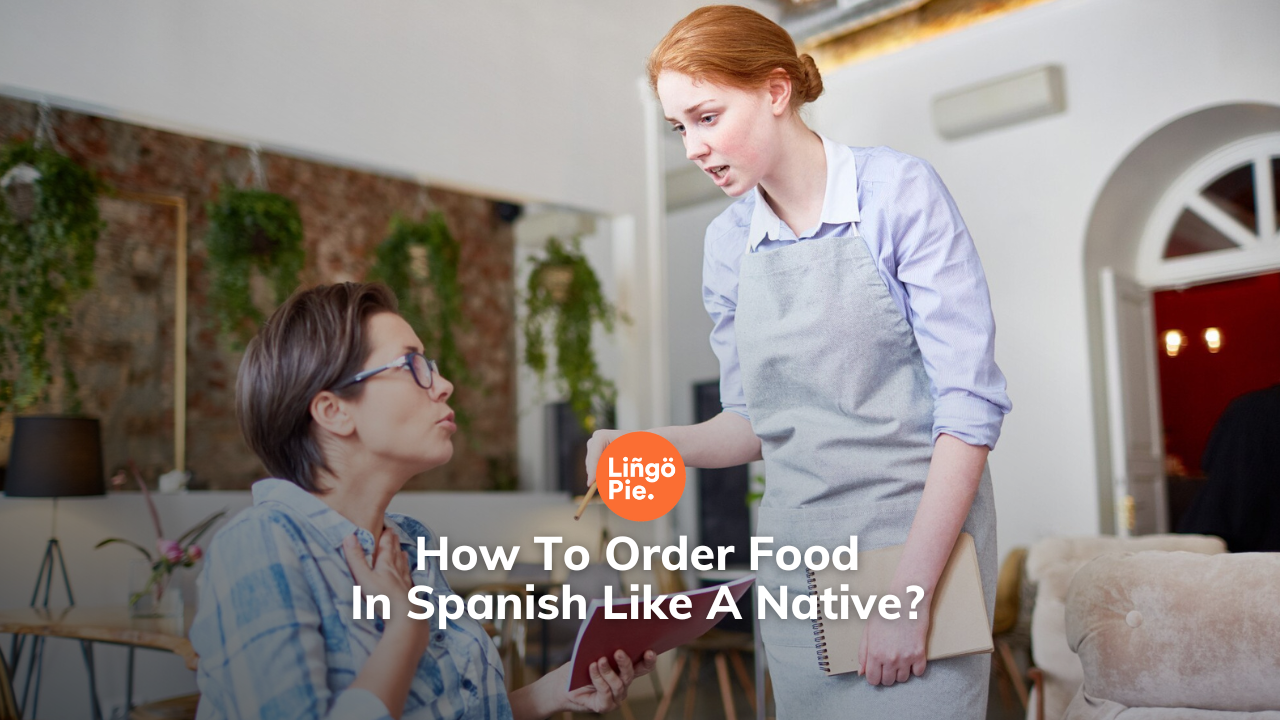When visiting a foreign country as a foreign traveler, it's crucial to learn the daily phrases in the local language to get by in the country. Ordering food is one of the most essential skills you'll need.
So, if you are traveling to Spain or South America, learning how to order food in Spanish is a survival skill you need. It can help you enjoy the local cuisine and talk to locals with confidence.
In this blog post, we'll help you learn must-know phrases to order food in Spanish like a native, so that you can order food anywhere with ease leaving no chance for misunderstandings.

Greetings
When dining at a Spanish restaurant, it's important to use appropriate Spanish greetings and polite expressions to show respect to the locals. Here are some basic phrases you can use everyday in a Spanish-speaking country:
● Hola! - Hello!
● Buenos días! - Good morning!
● Buenas tardes! - Good afternoon!
● Buenas noches! - Good evening!
● Una mesa para (número de personas), por favor. - A table for (number of people), please.
● Disculpe - Excuse me.
● Gracias - Thank you.
Asking For A Menu And Daily Specials

The first step of ordering food at a restaurant is asking for the menu. So you should learn how to ask for the menu or daily specials.This is essential to start your dining experience on the right note. Here are some useful Spanish phrases to ask for the menu:
● ¿Me podría dar el menú, por favor? - Could you give me the menu, please?
● ¿Puedo ver el menú, por favor? - Can I see the menu, please?
● ¿Cuál es el menú del día? - What is the menu of the day?
● ¿Tienen alguna especialidad hoy? - Do you have any specials today?
● ¿Podría recomendarme algo del menú? - Could you recommend something from the menu?
● ¿Qué platos recomienda? - What dishes do you recommend?
Asking About Ingredients And Allergies
When dining out, especially if you follow a special diet or you have allergies, you should learn how to ask about ingredients in a dish in Spanish. By using these Spanish phrases below, you can ensure that your dietary restrictions or allergies are understood. This is important for someone with allergies to enjoy their meal without any worries.
Here are some useful phrases to you can use in that case:
● ¿Qué ingredientes tiene este plato? - What ingredients does this dish have?
● ¿Este plato contiene (ingrediente)? - Does this dish contain [(ingredient)?
● ¿Podría decirme si este plato tiene (ingrediente)? - Could you tell me if this dish has (ingredient)?
● ¿Es este plato (vegetariano/vegano/sin gluten)? - Is this dish (vegetarian/vegan/gluten-free)?
● ¿Hay algún plato que no contenga (ingrediente)? - Is there any dish that does not contain (ingredient)?
● Soy alérgico/a a (alergeno) - I am allergic to (allergen)● Tengo una alergia a (alergeno) - I have an allergy to (allergen)
● ¿Este plato contiene (alergeno)? - Does this dish contain (allergen)?
● Necesito una dieta sin (ingrediente) - I need a diet without (ingrediente)
● Soy (vegetariano/vegano/celiaco) - I am (vegetarian/vegan/celiac)
Making Special Requests And Modifications

When dining at a restaurant, you may want to request changes in a dish to suit your taste or dietary needs. So, how can you request it in Spanish? Here are some phrases you can use:
● ¿Puedo tener esto sin (ingrediente)? - Can I have this without (ingredient)?
● Me gustaría esto, pero sin (ingrediente) - I would like this, but without (ingredient)
● ¿Es posible hacer este plato sin (ingrediente)? - Is it possible to make this dish without (ingredient)?
● ¿Pueden preparar esto con menos (ingrediente)? - Can you prepare this with less (ingredient)?
● Quisiera [plato] pero con (ingrediente) en lugar de (ingrediente) - I would like (dish) but with (ingredient) instead of (ingredient)
● ¿Me podría traer (artículo/condimento) extra, por favor? - Could you bring me extra (item/condiment), please?
● ¿Podría tener más (artículo/condimento)? - Could I have more (item/condiment)?
● ¿Tienen (condimento)? - Do you have (condiment)?
● Me gustaría un poco más de [artículo/condimento] - I would like a little more (item/condiment)
● ¿Puedo obtener (artículo/condimento) aparte? - Can I get (item/condiment) on the side?
Confirming And Clarifying Orders
When placing an order at a restaurant, it's important to confirm and clarify your order to make sure you receive exactly what you want. Here are some phrases you can use to confirm your order in Spanish:
● ¿Puede confirmar mi pedido, por favor? - Can you confirm my order, please?
● Quiero asegurarme de que pedí (plato) - I want to make sure I ordered (dish).
● ¿Es correcto que (detalle del pedido)? - Is it correct that (order detail)?
● Disculpe, creo que hay un error en mi pedido - Excuse me, I think there is a mistake in my order.
● Para aclarar, me gustaría (detalle del pedido) - To clarify, I would like (order detail).
Paying The Bill

When it comes to paying the bill at a restaurant, you should learn some key phrases to make the process easier. Here are some essential phrases you can use:
● La cuenta, por favor. - The bill, please
● ¿Podemos pagar por separado? - Can we pay separately?
● ¿Aceptan tarjetas de crédito? - Do you accept credit cards?
● ¿Incluye la propina? - Does it include the tip?
● Quisiera pagar en efectivo - I would like to pay in cash
● ¿Me podría dar el recibo, por favor? - Could you give me the receipt, please?
Conclusion
To wrap things up, knowing these Spanish phrases can really make a difference when you're eating out at a Spanish restaurant. It's not just about getting your order right; it's also about feeling more connected to the Spanish language and culture.
So, don't be shy! Give these phrases a try next time you're ordering food in Spanish. With a bit of practice, you'll be chatting with the waitstaff like a native and making your dining experience even better.
FAQs About Spanish Food Culture
1. What is a typical Spanish meal like?
A typical Spanish meal often starts with appetizers or tapas, followed by a main course, and ends with dessert. Lunch is the main meal of the day and is usually served between 2:00 PM and 4:00 PM, while dinner is lighter and served later, around 9:00 PM to 10:00 PM.
2. What are some must-try Spanish dishes?
Some must-try Spanish dishes include paella (a rice dish with seafood or meat), gazpacho (a cold tomato soup), jamón ibérico (cured ham), tortilla española (Spanish omelette), and churros con chocolate (fried dough with chocolate sauce).
3. What is the significance of tapas in Spanish culture?
Tapas are small dishes or appetizers that are an integral part of Spanish culture. They are meant to be shared and enjoyed with friends or family, often accompanied by a drink. Tapas are not just food; they represent a social and leisurely way of dining.
4. How important is seafood in Spanish cuisine?
Seafood is extremely important in Spanish cuisine, especially in coastal regions. Spain has a long tradition of fishing, and seafood dishes like gambas al ajillo (garlic shrimp), pulpo a la gallega (Galician-style octopus), and various types of seafood paella are popular.
5. What role does wine play in Spanish food culture?
Wine is an essential part of Spanish food culture, with the country being one of the world's largest wine producers. Each region has its own variety of wine, and it is common to pair meals with a local wine. Famous Spanish wines include Rioja, Cava, and Sherry.
Learn Spanish With Lingopie In A Natural Way!
Want to learn Spanish in a natural and immersive way? Lingopie can help you with that!
With Lingopie, you'll dive into a world of Spanish TV shows and movies which help you learn the language naturally. Whether you're a beginner or looking to brush up on your Spanish skills, Lingopie offers a unique and enjoyable way to pick up vocabulary, grammar, and cultural insights while improving your listening and speaking skills.
Is it possible to learn a language by watching movies? It is with Lingopie! Download the Lingopie app now from the App Storeor Play Store to get a free 7-day trial and start your Spanish learning journey right away!




![11 Best Apps To Learn Chinese [For All Levels]](/blog/content/images/2024/03/Spanish-1-6.png)

![30+ Modern English Slang Terms For Money [Guide]](/blog/content/images/size/w300/2025/06/Slang-term-for-money.jpg)
![5 Official Spanish Language Tests To Show Your Proficiency Level [Guide]](/blog/content/images/size/w300/2025/06/Spanish-Language-Tests.jpg)

![Why Memorizing Spanish Words Won’t Make You Fluent [Tips]](/blog/content/images/size/w300/2025/06/how-to-practice-spanish-vocabulary.jpg)